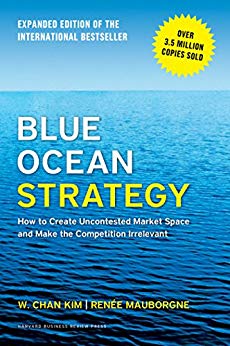

This article is an excerpt from the Shortform summary of "Blue Ocean Strategy" by W. Chan Kim and Renee Mauborgne. Shortform has the world's best summaries of books you should be reading.
Like this article? Sign up for a free trial here .
What is Blue Ocean Strategy about? What is the difference between a blue ocean and a red ocean?
In their book Blue Ocean Strategy, W. Chan Kim and Renée Mauborgne argue that the solution to business success is to operate in an uncontested market (the “blue ocean”). They contrast it with a “red ocean”, a marketplace where fierce competition has stained the water with the blood of the combatants. According to the authors, crowded markets and red ocean strategies tend to produce minimal profit margins, while blue ocean strategies lead to more profitable growth.
Below is a brief overview of the key themes discussed in the book.
1. Blue Ocean Innovation
In their book Blue Ocean Strategy, Kim and Mauborgne assert that the key to a successful business is to create what they call “value innovation”—an innovation that makes your product so unique and superior to the competition (and thus more valuable to your customers) that you open up uncontested markets and leave your rivals behind. In this case, value is the benefit that your customers get for their money, while innovation is the uniqueness and originality of the benefit.
(Shortform note: In a similar vein, Seth Godin argues Purple Cow that only remarkable products are likely to succeed. He says that to be remarkable, a product must be both unique enough to stand out from the crowd, and also practical enough that people want to buy it. This is another way of looking at blue ocean innovation: It’s figuring out how to make your product unique enough in a good way that it stands out and people want it.)
To create a blue ocean, Kim and Mauborgne say you need new ideas that redefine the market. They propose several approaches for brainstorming new ideas:
1. Consider Your Customer’s Alternatives
Kim and Mauborgne advise you to first consider the alternatives that your customer has, especially if they could achieve the same goal through different means. For example, rock-climbing gear and video games are different in form and function, but they fulfill the same basic goal of connecting with friends in a thrilling environment. Ask yourself if you could combine desirable features from different alternatives to provide unique value.
(Shortform note: It’s also worth considering what other goals a person could achieve with a product that is similar in form and function. In Crossing the Chasm, marketing consultant Geoffrey Moore defines alternate products that are different in form or function but achieve the same goal as market alternatives, and he contrasts them with product alternatives, which are similar in form or underlying technology but serve a different purpose. For example, an electric egg beater and an electric drill are used for completely different things, but they are made up of essentially the same components: an electric motor, a power supply, a gearbox, a coupling mechanism to hold the drill bits or beaters, and so forth. So, in addition to considering your product’s market alternatives as Kim and Mauborgne suggest, you might consider its product alternatives as well. Maybe you can create unique value by applying your product’s core technology to solve a different problem.)
2. Consider How Customers Weigh Price Against Performance
Kim and Mauborgne ask you to consider what characteristics motivate your customers to buy higher-quality products at higher prices versus lower quality at a lower price. Ask yourself if you can create a unique offering by focusing on the characteristics they are willing to pay extra for and eliminating the others.
(Shortform note: As you evaluate this, it may be helpful to rank your product and its features according to their technological maturity—the extent to which they’ve been proven. Then consider offering a premium model with all well-proven features, or an inexpensive minimalist model with only cutting-edge experimental features. This is potentially advantageous because technological maturity is one characteristic that often influences whether customers gravitate toward higher-priced or lower-priced models, as explained by marketing consultants Al Ries and Jack Trout in their book Positioning. They assert that people more readily embrace budget versions of new technology, because this allows them to try it out without risking as much money on it, but if the technology is mature, they are more receptive to premium versions.)
3. Consider Other Buyers in the Chain
Kim and Mauborgne suggest appealing to under-served people in the purchasing chain. If the end user and the person with purchasing power are not one and the same, the end user may have pain points, or persistent problems, you can address to provide unique value.
(Shortform note: Moore differentiates between three types of buyers: The economic buyer is the person who pays for the product or authorizes the purchase. The technical buyer is the person who sets up the product so it can be used. The end user, or functional buyer, is the person who uses the product once it’s set up. Each of these three may have their own unique pain points.)
4. Consider Complementary Products
Kim and Mauborgne note that products are rarely used in isolation. Consider what happens before, during, and after your product is used. Ask yourself if there’s friction between any of these handoffs that you could alleviate to create unique value. It might be as simple as bundling complementary products with yours.
(Shortform note: A key element of Moore’s strategy is assembling the “whole product.” Similar to Kim and Mauborgne’s observation, Moore points out that your core product offering typically only provides part of the whole solution that the customer needs, and he recommends forming alliances with other companies who can provide the other pieces of the puzzle.)
5. Consider Adding Function or Emotion
Kim and Mauborgne observe that most industries tend to gravitate toward either functionality or emotion. Consider making an emotional industry more functional by stripping away unnecessary extras, or making a functional industry more emotional.
For example, cosmetics tend to lean heavily toward emotion: They are designed and marketed to make customers feel beautiful. Meanwhile, house paint leans more toward function: It is designed to provide objective benefits like durability and the ability to match an existing color. But what if you took a more objective, “house paint” approach to selling cosmetics by citing a benefit such as being long-lasting? Or what if you created a line of “cosmetic” house paint that (together with your advertising) made homeowners feel better about themselves and their homes for using it?
(Shortform note: Be careful not to strip away too much emotional quality of your product—sales expert Oren Klaff argues that to pitch a product successfully to a prospective customer, you must appeal to the primitive, emotional side of the brain first. If you try to be too rational up front, the emotional center of the brain will filter out your message and it will never actually reach the rational part.)
6. Consider the Impact of Trends
If you can identify relevant market trends that have a clear direction, the authors advise you to consider what the market will look like if the trend is taken to its logical conclusion. Then assess how you could provide unique value to the new markets the trend creates.
(Shortform note: Trends analyst David Mattin argues that there is a simple key to understanding trends so that you can use them to your advantage in business: Instead of focusing on how things change over time, learn what doesn’t change. Understanding constants like human nature allows you to predict how new developments will play out.)
7. Consider the Needs of Potential Customers
Kim and Mauborgne advise you to reach beyond existing demand and include people who are not currently customers but may become so in your assessment. If you can solve a problem that is preventing people from buying products in your industry, you may create a blue ocean of new demand from both within and outside the traditional boundaries of the industry.
(Shortform note: Expanding your market to potential customers is also a key element of Moore’s strategy, but he presents it as a phased process: First you target a niche market, then as your product dominates that niche and gains credibility as the market leader there, you expand into another adjacent niche and repeat the process.)
How to Visualize Blue Ocean Innovation
To help visualize your strategy and see whether it provides unique value, Kim and Mauborgne introduce the blue ocean strategy chart, a graphic tool that they also call the “strategy canvas.” It consists of a two-dimensional line graph:
- On the horizontal axis, you list the characteristics of competition, that is, the attributes of your product.
- The vertical axis represents the value or emphasis you place on each characteristic.
Kim and Mauborgne explain that you plot the value of each characteristic on the graph as a point, and connect the points to create a strategy curve, which is essentially the path that your product follows across the various attributes. You do this both for your product (or prospective new offering) and its leading alternatives.
For example:
(Shortform note: Kim and Mauborgne’s strategy chart echoes the business trend of presenting business strategies succinctly on one sheet, such as an A3 Sheet, Business Model Canvas, or Lean Canvas. However, only the blue ocean strategy graph presents its information visually, which makes it more user-friendly—the other presentations require the user to read carefully through a lot of text and mentally evaluate how their product differs. For this reason, many find the blue ocean strategy chart easier to use.)
Kim and Mauborgne point out that if your product’s path closely follows another product (like Product X and Product Y in our example graph) then you’re not providing unique value—you’re applying a red-ocean strategy to compete directly with existing products. For a blue ocean strategy, you want your strategy curve to diverge significantly from every other company’s.
(Shortform note: Ries and Trout suggest that sometimes you can create unique value without changing the product itself just by identifying what makes your offering unique and showing customers why these differences are significant through advertising. For example, perhaps your product is just a little smaller than any of the others on the market, so you market your product as the only offering of its kind for children. If your marketing is successful, you’ve created a new characteristic (child friendliness) on the strategy chart without changing the product itself at all.)
The authors also note that if your curve is very flat, your offering may not be focused enough: You’re trying to be all things to all customers, and you’ll end up being a poor alternative for all of them.
(Shortform note: Ries and Trout likewise observe that appealing to a specific audience is crucial for successfully marketing a product, and add the nuance that maintaining this focus can be psychologically difficult because it’s counterintuitive: To target a specific market sector, you have to give up targeting other sectors, so you’re targeting fewer customers in order to make more sales. This counterintuitiveness makes it easy to make the mistake of trying to be everything to everyone.)
2. Strategic Pricing
You’ve got a product that provides unique value, but to benefit from this blue ocean, you need to price it right. Kim and Mauborgne recommend a three-step process for selecting your price and ensuring the profitability of your blue ocean.
(Shortform note: In Crossing the Chasm, Moore identifies three basic pricing strategies, which provide useful context for this discussion: Customer-oriented pricing is when you set your price based on how much value your product provides to the customer and what they’ll likely expect, given their alternatives. Vendor-oriented pricing is where you set your price based on your own costs and desired profit margin. Distributor-oriented pricing is where you set your price to motivate your distributors by making your product the most profitable thing for them to sell.)
Step 1: Identify Your Price Range
Kim and Mauborgne recommend cataloging the price of your customers’ alternatives and using this data to establish a range of prices that will be competitive with these alternatives. They say this will help to maximize your customer base, and thus your revenue.
| This is what Moore would call “customer-oriented pricing” (setting prices based on value to the customer or customer expectations). Moore, however, doesn’t advise that you use customer-oriented pricing, but instead advocates for distributor-oriented pricing, which is pricing your product such that it is the most profitable thing your distributor can sell, so that your distributor is motivated to go the extra mile when it comes to pushing your product. Note that Moore developed his strategy for Crossing the Chasm specifically for high-tech business-to-business products, where the distributor often plays a crucial role in adoption: A leading vendor in a given industry can give a new product instant credibility by choosing to distribute it. Because this pricing model applies to such a specific situation, this method may not be useful for your product. However, Moore’s strategy may offer advantages in any venue where your distributor plays a particularly significant role in determining your sales volume. |
Step 2: Choose a Price Within the Range
Once you’ve identified your price range, Kim and Mauborgne advise you to select a price in that range based on two characteristics:
- Defensibility: The harder it will be for your competitors to imitate your product (due to patent protection, trade secrets, or other unique advantages that your company has) the higher you can set your price.
- Scale: The greater the economies of scale (how much the cost per unit decreases with increasing volume) and the greater the network effects (how much the usefulness or attractiveness of your product increases as the user base grows), the lower you’ll want to set your price, to stimulate broad adoption.
(Shortform note: Arguably, scale is just part of defensibility, because the first-scalar advantage makes your product harder to imitate. If your product has significant network effects, in which having a large user base makes it more valuable to your customers, it will be harder for rivals to compete with you. Even without network effects, the larger your operation, the more expensive it is for others to replicate.)
Step 3: Manage Costs to Achieve a Profit Margin
Once you have your strategic price, Kim and Mauborgne advise you to calculate your target cost by deciding what profit margin you want and then applying it to your chosen price. They argue that you must not let costs dictate prices, nor should you lower your product’s benefits to match its costs, because doing so will jeopardize mass adoption. If you cannot reduce your costs to a level that allows for adequate profit, then they say your idea won’t work and you need to go back to the drawing board.
(Shortform note: Kim and Mauborgne’s directive to figure out your target price first and then manage your costs to achieve it could be considered a business application of Stephen Covey’s directive to begin with your goal in mind. Beginning with a clear understanding of the desired end-state (or in this case the retail price) allows you to chart a course to it and assess its feasibility more definitively.)
3. Execution
Now that you’ve got a strategy, it’s time to execute it. Kim and Mauborgne identify four hurdles that you’ll have to overcome to implement a blue ocean strategy at your company, and offer advice on how to overcome them.
1. The recognition shortfall: Before you can implement a blue ocean solution, you have to convince your stakeholders that there’s a problem worth solving. Arrange for them to meet dissatisfied customers, or otherwise bring them face to face with the problem, rather than relying on impersonal metrics.
(Shortform note: Make sure you’re personally familiar with the problem yourself too, so you can present your solution at a personal level, in a way that will serve your stakeholders’ best interests. According to Daniel Pink, this is one of the keys to effective selling.)
2. The capital shortfall: Kim and Mauborgne observe that companies in need of strategic change often have a resource shortfall. To work with this problem, the authors advise you to consider where your resources are earning the highest and lowest value per dollar spent, so that you can maximize your returns by shifting resources around.
(Shortform note: In The 48 Laws of Power, Robert Greene echoes this principle and generalizes it, saying that the key to moving forward is focusing on what will generate the greatest benefit. He applies this not only to physical resources but also to relationships and alliances.)
3. The initiative shortfall: Instilling in your team the motivation to make the change can be a hurdle in itself. Kim and Mauborgne advise breaking down your strategy into small, actionable blocks so the change doesn’t seem so daunting.
(Shortform note: In Tiny Habits, Dr. BJ Fogg proposes that the key to changing a person’s behavior is designing a change that’s small enough they don’t need tremendous motivation to change.)
The authors also emphasize the importance of making your strategy implementation a fair process in order to rally your team behind it. If your team members feel listened to and respected in the decision-making process, they’ll more likely go along with a decision even if they personally disagree with it.
(Shortform note: In Never Split the Difference, Chris Ross and Tahl Raz observe that people will often go out of their way to oppose anything they see as unfair, even if it means making irrational choices. This is what you are trying to avoid: If people perceive your blue ocean strategy as an unfair change in the direction of the company, they may reject it despite its merits.)
4. The cooperation shortfall: Kim and Mauborgne observe that organizations often have internal battles to get things done. They advise having one person on your strategic management team who knows the corporate politics from firsthand experience. Her function is to help you anticipate who will side with you or against you, understand the opposition, and mobilize support.
(Shortform note: In The 48 Laws of Power, Robert Greene emphasizes that knowing your opponents’ secrets allows you to predict their behavior and ultimately control them. He suggests that if you engage with people in a friendly, interested manner, in a social setting, they will often reveal their interests, plans, and even weaknesses. If you are too well-known as a supporter of the coming changes, and you suspect that opponents of the changes won’t open up to you directly, you need someone on your team who can socialize for you to find out how people really feel.)
———End of Preview———

Like what you just read? Read the rest of the world's best summary of "Blue Ocean Strategy" at Shortform . Learn the book's critical concepts in 20 minutes or less .
Here's what you'll find in our full Blue Ocean Strategy summary :
- What blue oceans are, and how you create one for your business
- Why some businesses succeed in creating blue oceans, and why others fail
- The red ocean traps you have to avoid if you want business growth






